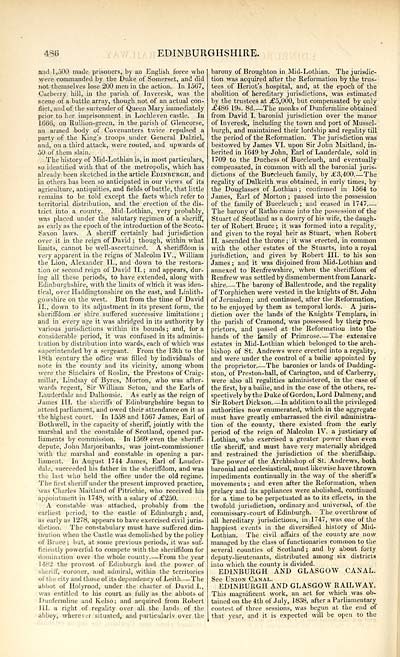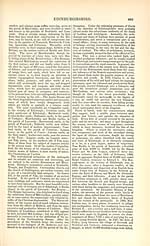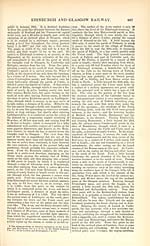Topographical, statistical, and historical gazetteer of Scotland > Volume 1
(578) Page 486
Download files
Complete book:
Individual page:
Thumbnail gallery: Grid view | List view

436
EDINBURGHSHIRE.
and 1,500 made prisoners, by an English force who
were commanded by the Duke of Somerset, and did
not themselves lose 200 men in the action. In 1567,
Carberry hill, in the parish of Inveresk, was the
scene of a battle array, though not of an actual con-
flict, and of the surrender of Queen Mary immediately
prior to her imprisonment in Lochleven castle. In
1666, on Rullion-green, in the parish of Glencorse,
an armed body of Covenanters twice repulsed a
party of the King's troops under General Dalziel,
and, on a third attack, were routed, and upwards of
50 of them slain.
The history of Mid-Lothian is, in most particulars,
so identified with that of the metropolis, which has
already been sketched in the article Edinburgh, and
in others has been so anticipated in our views of its
agriculture, antiquities, and fields of battle, that little
remains to be told except the facts which refer to
territorial distribution, and the erection of the dis-
trict into a county. Mid-Lothian, very probably,
was placed under the salutary regimen of a sheriff,
as early as the epoch of the introduction of the Scoto-
Saxon laws. A sheriff certainly had jurisdiction
over it in the reign of David ; though, within what
limits, cannot be well-ascertained. A sheriffdom is
very apparent in the reigns of Malcolm IV., William
the Lion, Alexander II., and down to the restora-
tion or second reign of David II. ; and appears, dur-
ing all these periods, to have extended, along with
Edinburghshire, with the limits of which it was iden-
tical, over Haddingtonshire on the east, and Linlith-
gowshire on the west. But from the time of David
II., down to its adjustment in its present form, the
sheriffdom or shire suffered successive limitations ;
and in every age it was abridged in its authority by
various jurisdictions within its bounds; and, for a
considerable period, it was confused in its adminis-
tration by distribution into wards, each of which was
superintended by a sergeant. From the 13th to the
18th century the office was filled by individuals of
note in the county and its vicinity, among whom
were the Sinclairs of RosUn, the Prestons of Craig-
millar, Lindsay of Byres, Morton, who was after-
wards regent, Sir William Seton, and the Earls of
Lauderdale and Dalhousie. As early as the reign of
James III. the sheriffs of Edinburghshire began to
attend parliament, and owed their attendance on it as
the highest court. In 1558 and 1567 James, Earl of
Bothwell, in the capacity of sheriff, jointly with the
marshal and the constable of Scotland, opened par-
liaments by commission. In 1569 even the sheriff-
depute, John Marjoribanks, was joint-commissioner
with the marshal and constable in opening a par-
liament. In August 1744 James, Earl of Lauder-
dale, succeeded his father in the sheriffdom, and was
the last who held the office under the old regime.
The first sheriff under the present improved practice,
was Charles Maitland of Pitrichie, who received his
appointment in 1 748, with a salary of .£250.
A constable was attached, probably from the
earliest period, to the castle of Edinburgh ; and,
as early as 1278, appears to have exercised civil juris-
diction. The constabulary must have suffered dim-
inution when the Castle was demolished by the policy
of Bruce ; but, at some previous periods, it was suf-
ficiently powerful to compete with the sheriffdom for
domination over the whole county From the year
1-482 the provost of Edinburgh had the power of
sheriff, coroner, and admiral, within the territories
of the city and those of its dependency of Leith The
abbot of Holyrood, under the charter of David I.,
was entitled to his court as fully as the abbots of
Dunfermline and Kelso; and acquired from Robert
III. a right of regality over all the lands of the
abbey, wherever situated, and particularlv over the
barony of Broughton in Mid-Lothian. The jurisdic-
tion was acquired after the Reformation by the trus-
tees of Heriot's hospital, and, at the epoch of the
abolition of hereditary jurisdictions, was estimated
by the trustees at £5,000, but compensated by only
£486 19s. 8d The monks of Dunfermline obtained
from David I. baronial jurisdiction over the manor
of Inveresk, including the town and port of Mussel-
burgh, and maintained their lordship and regality till
the period of the Reformation. The jurisdiction was
bestowed by James VI. upon Sir John Maitland, in-
herited in 1649 by John, Earl of Lauderdale, sold in
1709 to the Duchess of Buccleuch, and eventually
compensated, in common with all the baronial juris-
dictions of the Buccleuch family, by £3,400 The
regality of Dalkeith was obtained, in early times, by
the Douglasses of Lothian ; confirmed in 1564 to
James, Earl of Morton ; passed into the possession
of the family of Buccleuch ; and ceased in 1747
The barony of Ratho came into the possession of the
Stuart of Scotland as a dowry of his wife, the daugh-
ter of Robert Bruce ; it was formed into a regality,
and given to the royal heir as Stuart, when Robert
II. ascended the throne; it was erected, in common
with the other estates of the Stuarts, into a royal
jurisdiction, and given by Robert III. to his son
James ; and it was disjoined from Mid-Lothian and
annexed to Renfrewshire, when the sheriffdom of
Renfrew was settled by dismemberment from Lanark-
shire. — The barony of Ballentrode, and the regality
of Torphichen were vested in the knights of St. John
of Jerusalem; and continued, after the Reformation,
to be enjoyed by them as temporal lords. A juris-
diction over the lands of the Knights Templars, in
the parish of Cramond, was possessed by theij pro-
prietors, and passed at the Reformation into tbe
hands of the family of Primrose The extensive
estates in Mid-Lothian which belonged to the arch-
bishop of St. Andrews were erected into a regality,
and were under the control of a bailie appointed by
the proprietor.. — The baronies or lands of Dudding-
ston, of Preston-hall, of Carington, and of Carberry,
were also all regalities administered, in the case of
the first, by a bailie, and in the case of the others, re-
spectively by the Duke of Gordon, Lord Dalmeny, and
Sir Robert Dickson In addition to all the privileged
authorities now enumerated, which in the aggregate
must have greatly embarrassed the civil administra-
tion of the county, there existed from the early
period of the reign of Malcolm IV. a justiciary of
Lothian, who exercised a greater power than even
the sheriff, and must have very materially abridged
and restrained the jurisdiction of the sheriffship.
The power of the Archbishop of St. Andrews, both
baronial and ecclesiastical, must likewise have thrown
impediments continually in the way of the sheriff's
movements ; and even after the Reformation, when
prelacy and its appliances were abolished, continued
tor a time to be perpetuated as to its effects, in the
twofold jurisdiction, ordinary and universal, of the
commissary-court of Edinburgh. The overthrow of
all hereditary jurisdictions, in 1747, was one of the
happiest events in the diversified history of Mid-
Lothian. The civil affairs of the county are now
managed by the class of functionaries common to the
several counties of Scotland; and by about forty
deputy-lieutenants, distributed among six districts
into which the county is divided.
EDINBURGH AND GLASGOW CANAL.
See Union Canal.
EDINBURGH AND GLASGOW RAILWAY.
This magnificent work, an act for which was ob-
tained on the 4th of July, 1838, after a Parliamentary
contest of three sessions, was begun at the end of
that year, and it is expected will be open to the
EDINBURGHSHIRE.
and 1,500 made prisoners, by an English force who
were commanded by the Duke of Somerset, and did
not themselves lose 200 men in the action. In 1567,
Carberry hill, in the parish of Inveresk, was the
scene of a battle array, though not of an actual con-
flict, and of the surrender of Queen Mary immediately
prior to her imprisonment in Lochleven castle. In
1666, on Rullion-green, in the parish of Glencorse,
an armed body of Covenanters twice repulsed a
party of the King's troops under General Dalziel,
and, on a third attack, were routed, and upwards of
50 of them slain.
The history of Mid-Lothian is, in most particulars,
so identified with that of the metropolis, which has
already been sketched in the article Edinburgh, and
in others has been so anticipated in our views of its
agriculture, antiquities, and fields of battle, that little
remains to be told except the facts which refer to
territorial distribution, and the erection of the dis-
trict into a county. Mid-Lothian, very probably,
was placed under the salutary regimen of a sheriff,
as early as the epoch of the introduction of the Scoto-
Saxon laws. A sheriff certainly had jurisdiction
over it in the reign of David ; though, within what
limits, cannot be well-ascertained. A sheriffdom is
very apparent in the reigns of Malcolm IV., William
the Lion, Alexander II., and down to the restora-
tion or second reign of David II. ; and appears, dur-
ing all these periods, to have extended, along with
Edinburghshire, with the limits of which it was iden-
tical, over Haddingtonshire on the east, and Linlith-
gowshire on the west. But from the time of David
II., down to its adjustment in its present form, the
sheriffdom or shire suffered successive limitations ;
and in every age it was abridged in its authority by
various jurisdictions within its bounds; and, for a
considerable period, it was confused in its adminis-
tration by distribution into wards, each of which was
superintended by a sergeant. From the 13th to the
18th century the office was filled by individuals of
note in the county and its vicinity, among whom
were the Sinclairs of RosUn, the Prestons of Craig-
millar, Lindsay of Byres, Morton, who was after-
wards regent, Sir William Seton, and the Earls of
Lauderdale and Dalhousie. As early as the reign of
James III. the sheriffs of Edinburghshire began to
attend parliament, and owed their attendance on it as
the highest court. In 1558 and 1567 James, Earl of
Bothwell, in the capacity of sheriff, jointly with the
marshal and the constable of Scotland, opened par-
liaments by commission. In 1569 even the sheriff-
depute, John Marjoribanks, was joint-commissioner
with the marshal and constable in opening a par-
liament. In August 1744 James, Earl of Lauder-
dale, succeeded his father in the sheriffdom, and was
the last who held the office under the old regime.
The first sheriff under the present improved practice,
was Charles Maitland of Pitrichie, who received his
appointment in 1 748, with a salary of .£250.
A constable was attached, probably from the
earliest period, to the castle of Edinburgh ; and,
as early as 1278, appears to have exercised civil juris-
diction. The constabulary must have suffered dim-
inution when the Castle was demolished by the policy
of Bruce ; but, at some previous periods, it was suf-
ficiently powerful to compete with the sheriffdom for
domination over the whole county From the year
1-482 the provost of Edinburgh had the power of
sheriff, coroner, and admiral, within the territories
of the city and those of its dependency of Leith The
abbot of Holyrood, under the charter of David I.,
was entitled to his court as fully as the abbots of
Dunfermline and Kelso; and acquired from Robert
III. a right of regality over all the lands of the
abbey, wherever situated, and particularlv over the
barony of Broughton in Mid-Lothian. The jurisdic-
tion was acquired after the Reformation by the trus-
tees of Heriot's hospital, and, at the epoch of the
abolition of hereditary jurisdictions, was estimated
by the trustees at £5,000, but compensated by only
£486 19s. 8d The monks of Dunfermline obtained
from David I. baronial jurisdiction over the manor
of Inveresk, including the town and port of Mussel-
burgh, and maintained their lordship and regality till
the period of the Reformation. The jurisdiction was
bestowed by James VI. upon Sir John Maitland, in-
herited in 1649 by John, Earl of Lauderdale, sold in
1709 to the Duchess of Buccleuch, and eventually
compensated, in common with all the baronial juris-
dictions of the Buccleuch family, by £3,400 The
regality of Dalkeith was obtained, in early times, by
the Douglasses of Lothian ; confirmed in 1564 to
James, Earl of Morton ; passed into the possession
of the family of Buccleuch ; and ceased in 1747
The barony of Ratho came into the possession of the
Stuart of Scotland as a dowry of his wife, the daugh-
ter of Robert Bruce ; it was formed into a regality,
and given to the royal heir as Stuart, when Robert
II. ascended the throne; it was erected, in common
with the other estates of the Stuarts, into a royal
jurisdiction, and given by Robert III. to his son
James ; and it was disjoined from Mid-Lothian and
annexed to Renfrewshire, when the sheriffdom of
Renfrew was settled by dismemberment from Lanark-
shire. — The barony of Ballentrode, and the regality
of Torphichen were vested in the knights of St. John
of Jerusalem; and continued, after the Reformation,
to be enjoyed by them as temporal lords. A juris-
diction over the lands of the Knights Templars, in
the parish of Cramond, was possessed by theij pro-
prietors, and passed at the Reformation into tbe
hands of the family of Primrose The extensive
estates in Mid-Lothian which belonged to the arch-
bishop of St. Andrews were erected into a regality,
and were under the control of a bailie appointed by
the proprietor.. — The baronies or lands of Dudding-
ston, of Preston-hall, of Carington, and of Carberry,
were also all regalities administered, in the case of
the first, by a bailie, and in the case of the others, re-
spectively by the Duke of Gordon, Lord Dalmeny, and
Sir Robert Dickson In addition to all the privileged
authorities now enumerated, which in the aggregate
must have greatly embarrassed the civil administra-
tion of the county, there existed from the early
period of the reign of Malcolm IV. a justiciary of
Lothian, who exercised a greater power than even
the sheriff, and must have very materially abridged
and restrained the jurisdiction of the sheriffship.
The power of the Archbishop of St. Andrews, both
baronial and ecclesiastical, must likewise have thrown
impediments continually in the way of the sheriff's
movements ; and even after the Reformation, when
prelacy and its appliances were abolished, continued
tor a time to be perpetuated as to its effects, in the
twofold jurisdiction, ordinary and universal, of the
commissary-court of Edinburgh. The overthrow of
all hereditary jurisdictions, in 1747, was one of the
happiest events in the diversified history of Mid-
Lothian. The civil affairs of the county are now
managed by the class of functionaries common to the
several counties of Scotland; and by about forty
deputy-lieutenants, distributed among six districts
into which the county is divided.
EDINBURGH AND GLASGOW CANAL.
See Union Canal.
EDINBURGH AND GLASGOW RAILWAY.
This magnificent work, an act for which was ob-
tained on the 4th of July, 1838, after a Parliamentary
contest of three sessions, was begun at the end of
that year, and it is expected will be open to the
Set display mode to: Large image | Transcription
Images and transcriptions on this page, including medium image downloads, may be used under the Creative Commons Attribution 4.0 International Licence unless otherwise stated. ![]()
| Gazetteers of Scotland, 1803-1901 > Topographical, statistical, and historical gazetteer of Scotland > Volume 1 > (578) Page 486 |
|---|
| Permanent URL | https://digital.nls.uk/97444482 |
|---|
| Description | Volume first. A-H. |
|---|---|
| Attribution and copyright: |
|

